Otters are some of the rarest domesticated pets in the world. Because of numerous factors, several states, especially in the USA, are restricted from legally owning an otter. Even so, there are other states that allow their citizens to legally adopt one.
In the following sections find out more about what otters are, if they are dangerous or friendly as pets, their diet, habitat, plus more interesting fun and interesting facts.
What’s an Otter and What does it look like?
It is a mammal with an elongated body, dense fur, and webbed feet found both on land and in water. It is of the Mustelid family, or rather the Mustelidae genus – the same family as weasels, badgers, and minks. However, they are from a different subfamily known as Lutrinae.
What do otters look like?
Otters have long and sleek bodies with dense fur that keeps warm, short legs with webbed feet, powerful tails which act like rudders, small ears, and nostrils that can close underwater. They have a pale belly and their fur can be shiny or light brown.
Cute Baby Otter Pictures
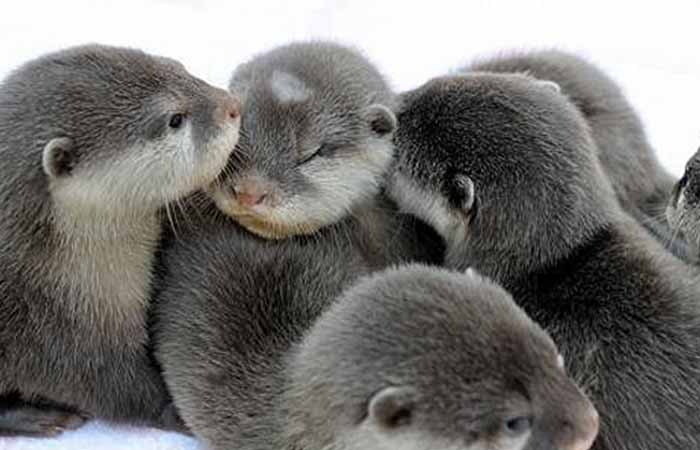

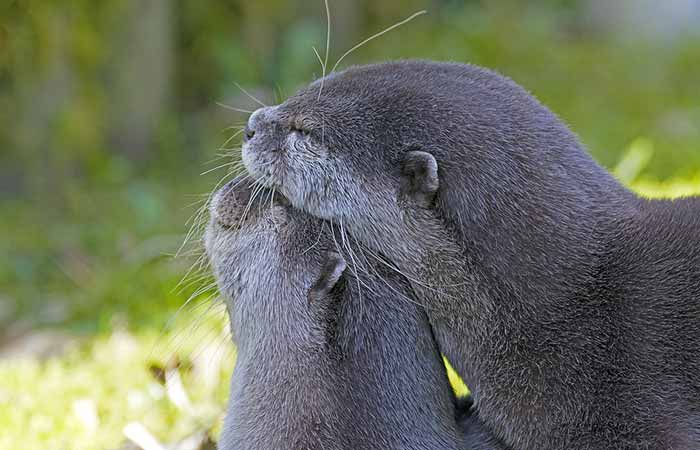
Their unique structure and physique, as well as other admirable features, renders them to slowly become extinct. This applies to all its 13 species. Hence, one of the reasons governments and other wildlife conservation organizations are trying to protect them, even from adoption by ordinary humans.
The most common species of otters available are;
- European otter – also known as the Lutra lutra, they originated from Europe and the northern Arctic and have since then migrated to northern Africa and other parts of Asia. They aren’t that many because of human trapping.
- Enhydra lutris – what you commonly call the sea otter. They live around and in the sea. Because of the water’s cold temperatures, they have the thickest fur to protect them. This also makes them an endangered species.
- N. American river otter – unlike the Enhydra, the Lotra Canadensis lives on the shores of rivers and coasts. You will often see them making caves close to these water bodies si they can play on the land and in the water.
- Giant otter – this species is the longest of them all, while the sea otter takes the medal for weight and abundance in fur. Luckily for the giant otter, there aren’t really hunted and preyed on.
- Aonyx cinera – a small-clawed otter from Asia with webbed feet and the tiniest body structure. The webbed feet make them a unique species and lucky to be able to be domesticated by law.
These are only but the most common species in the world, the other seven remaining species are significantly reduced to near extinction. From the list above, the most common species is the smallest ( Asian small-clawed otter).
The rest of the species are considered highly endangered and therefore protected by the government and other wildlife conservation agencies. Most especially the northern American river otter, which is quite common in Mexico as well, should not be adopted by anyone in any state in the USA.
Are otters Dangerous, Mean/Aggressive as Pets?
Otters are very playful and charming and it might seem easy to interact with them or have them as pets. However, just like any other wild animal, otters can be dangerous and aggressive.
Otters can be dangerous around children, full grown adults as well as pets. They tend to attack when they are intimidated. When threatened, they can use their sharp claws/teeth to attack pets or even children.
They are very mean especially when it comes to protecting their territory. They love their space and hate intruders.
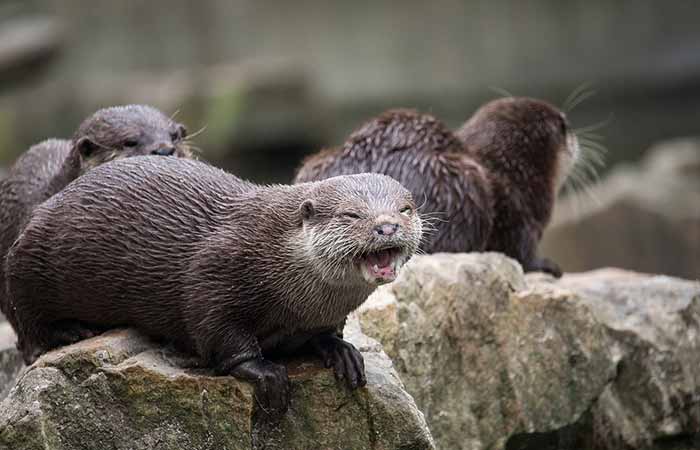
The remains of their prey and their fecal waste pollute the environment and can also attract pests.
They are prone to pests such as ticks and lice which may lead to the spread of infestations to humans.
Besides legal restrictions that don’t allow for people to own otters as their pets, there are numerous other reasons you can’t and shouldn’t have an otter as a pet.
Otters are Wild and can Messy in Captivity
Otters have and will always be wild animals. Their nature of hunting, as well as behavioral characteristics, show their liking to be free from captivity and their liking to natural habitats.
They can be quite messy- since they are wild, they are used to leaving their wastes and remain of their food everywhere. If they do this in the house, then the house gets littered and it might be tiring for you to clean each time they mess up the place.
They are very noisy.
Otters can be really loud and cause a lot of annoyance in households. The noises might be too loud to bear with.
Undesirable odor
They have a body odor which is very unpleasant. It is also thought that they mark their territory by releasing these toxic gases from their sweat glands located at the base of their tail. Their fecal matter also contributes to the bad odor around homes thus keeping them as pets might not be a very good idea.
They Require Lots of Space
Otters are extra playful. Jumping from area to the next, in the sea and on the land, hiding in the caves and strolling the land as they hunt their next meal. These plus other reasons render them horrible pets as they don’t tend to settle in one area.
This also means they are very disruptive. The constant movements up and down your home once you adopt them can damage items in your home causing you huge losses. Their nature dictates that they love a free and enriched environment. An area full of space for them to run around aimlessly.
The recommended space is about 60m2 which can equivalent the size of an apartment. Yes, that big of a space for that small fella. What’s more, that only caters to one otter whereas, the IUCN guidelines state that otters require at least one other company which means you will need almost another 10m2 extra space to accommodate a pair of otters.
Habitat Requirements
Otters have a different form of livelihood. They love to be surrounded by water and land, especially for the Asian small-clawed otters. They are playful, yes, and they enjoy large spaces, but they also burrow the land. This means they need the right type of terrain to easily burrow into the land and out.
They also need to be surrounded by nature – trees and such, so they can scavenge around. Unlike other settled pets, otters want to left alone to climb trees with their dexterous claws. Keeping them in small enclosures can make them agitated and make them want to escape. Hence, you need to have a high wall of a fence that they can’t climb out of.
What’s more, since the burrow, you have to ensure they don’t burrow down and come out the other side of the fence. They require walkways, natural shrubbery, nesting boxes and lots of options for safe digging and foraging.
They have very Specific Needs
This isn’t about their environment; otters need safe and warm water temperatures. Local climatic conditions may not suit the needs of the otter. What’s more, the water has to free from disease-causing infections from bacteria.
The care they need is paramount otherwise they can easily die from untreated water. They also need proportionate quantities of food to supplement their diet. That should equate to at least 350 g of food per day.
It is Extremely Expensive Choice
Up to that point, you can see how expensive it is to own and maintain an otter. You will require numerous resources to offer the right type of enclosure for your otter. Besides that, you haven’t factored in checkups with veterinarians which would be exorbitant since the animal itself is a special breed.
This just goes to say that it’s an expensive choice of a pet compared to others. Jot to mentions the legal implications you will have if anything goes wrong with the otter while it was under your care.
The International Union for Conservation of Nature (IUCN) created a general guideline on how these otters can be cared for while in captivity. Their main agenda may have been to protect them from extinction and harm from trappers who eye their fur, but on a general note, otters are not to be kept in captivity due to their adaptation to the wild surroundings.
Why Otters can be Friendly Pets
Pets are meant to be friendly companions to humans-harmless, playful and not a burden to the owner. These are some of the reasons you can own an otter as a pet.
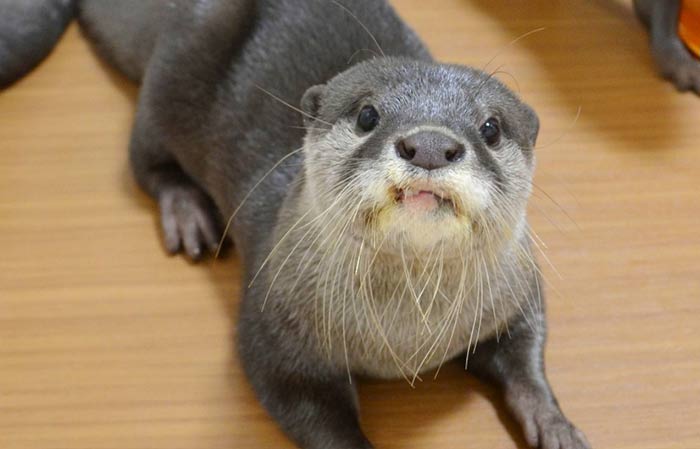
Playful and active
As mentioned earlier, otters are from the mustelid family. They behave almost similar to ferrets which are commonly adopted by multiple families. They love to play around, jump up and down, swim, and stroll the land.
With enough home space, this mustelid can actually enjoy the security of a home. Protected from the harsh reality of predators and human trappers.
The most common species that is usually preferred for a pet is the Asian small-clawed otter since it very small. Also, the fresh water otters can be kept as pets though they might be disadvantaged because the artificial aquatic environment that you offer them might not match the natural one they are used to.
Not Illegal in Some States
Frankly, some people want to keep a pet because they can. As exotic as these otters are, some states in the USA allow one to legally adopt and take care of them. They can have demands depending on the nature of the care they need, but they are also endangered, hence special.
States Where Pet Otters are Possibly Legal
The list below is not an exhaustive list of all the areas one can adopt. This is because different rules govern different jurisdictions, which are subject to change every now and then. Hence, below are the most common areas that have been spotted to allow one to legally adopt otters.
The states include;
- Nevada
- North Carolina
- New York
- Florida
- Indiana
- Minnesota
- Mississippi
- Ohio
- Oklahoma
- South Dakota
- Tennessee
It is crucial to note that outside of the USA, Japan is also a common region you will find these exotic pets. However, there are also claims that as more and people claim otter is their pet fad, it has become as dangerous affair as some are moving to the extent of sneaking otters into their illegally.
Even so, more and more regions are revising laws to allow for more and more people to adopt these wildlife creatures.
Being aquatic, otters will need a pool or large bath tabs. They also need a dry space since they are do not spend all their time in water. Otters like to roam around so ensure that you have enough space for them. This will ensure that they do not feel like they’re constrained.
For the purposes of hygiene, it is better not to keep otters in the house. You could have space for them outside where they can dig dens or even play since they are playful creatures. This might be important in ensuring that the otters feel at home even if they are not in their natural habitat.
Their diet is also something that should be keenly checked. All otter are carnivorous so that means their diet should mostly consist of meat.
Being wild animals, otters too need to be left free without being constrained in the house. If constrained in the house, they might get very aggressive or even feel so lonely.
Where do Otters Live and Sleep
Otters are mostly found around watery places like ponds, rivers and lakes. They live and give birth in dens that have used before by animals like beavers. However, the sea otters are unique because they live and give birth in water.
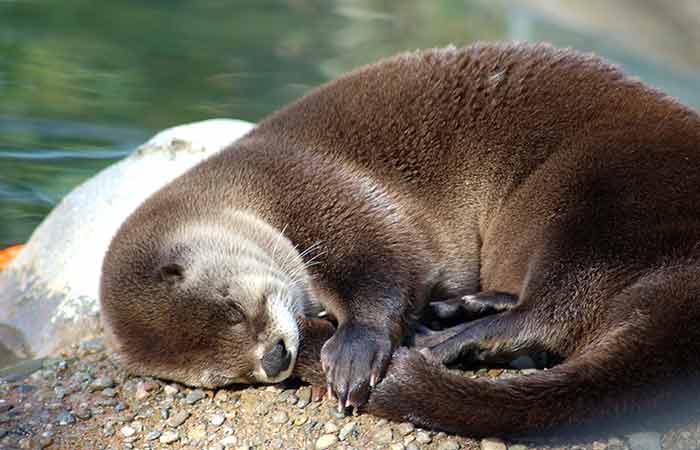
Otters sleep in dens or above the ground. They can also sleep in the water, where they lay on their backs on the surface. They generally prefer quite areas with moderate disturbance. When sleeping in the sea, otters will usually sleep in kelp strands, which keeps them from drifting too far.
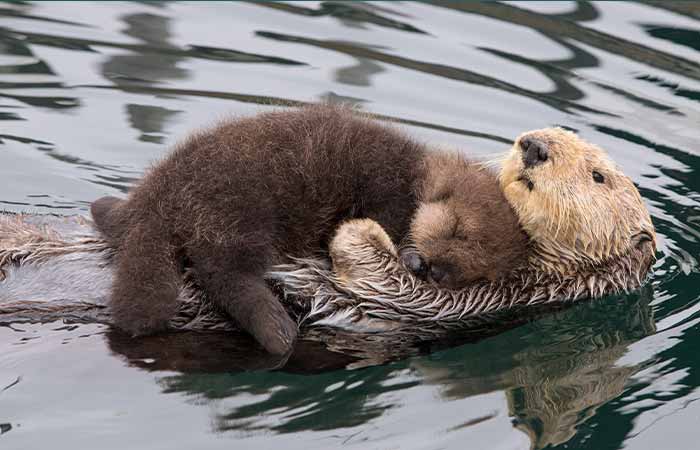
What do Otters Eat?
Otters are carnivorous. Their diet might differ depending on their location, species and also season.
The giant otters feed on fishes and crabs. Sea otters feed on fishes too and marine invertebrates such as mussels, crabs, snails and abalones among others. River otters prey on crayfishes, crabs and other invertebrates including fishes and frogs.
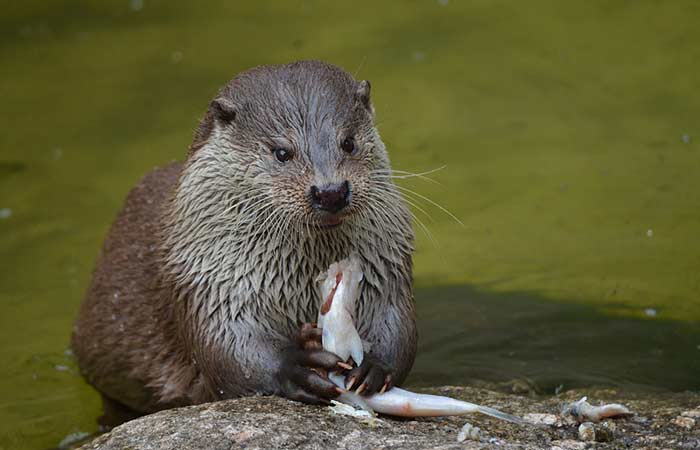
Fish is not a major diet for Cape clawless otters and Asian small-clawed otters because their diet is mainly made up of crabs, frogs and crustaceans. The Congo clawless otters eat soft foods such as frogs and eggs.
The smooth otter feeds on large fishes while the Eurasian otters feed on amphibians and small fishes.
Otters are differently adapted to their feeding depending on the type of diet they feed on.
The sea otters are great swimmers thus they are able to swim deep to catch their prey. They eat their food is water as they lie on their backs while placing the food on their chests. Clawless otters use their paws to catch prey.
Giant otters also use their paws to hold their prey in position as they feed on it. Cape clawless otters use rocks or hard objects to break the shells of their prey. River otters use their vibrissae to perceive any movement in water and use their mouths to get hold of their prey. This is a mechanism that is also used by giant otters.
How Big are Otters?
The size of otters is different depending on the species and gender too. The male otters are bigger than the female otters. Young otters weigh about two ounces when born and are about 56-61cm.
River otters weigh about 3-14kg and are 87-153cm long. Giant otters are averagely 145 to 180cm long. Their weight is different in both males and females where the females weigh 22-26kgs and the male 26-34kg.
The Asian small-clawed is not that big since it only weighs 1-5kgs and measure 65-94cm.
The size of sea otters varies in Alaska and California. In Alaska, the male sea otters are 148cm and 27-39kg while the females are 140cm long and 16-27kg. In California, male sea otters are 122cm and weigh about 29kg while the females are about 20kg.
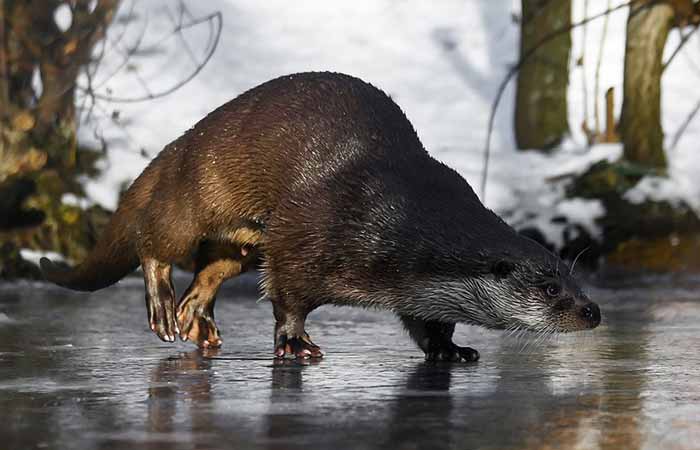
How long do Otters Live?
The average lifespan of an otter is 10 years. However, how long they live can vary depending on the species and the habitat.
The sea otters are believed to live longer than other otters while the giant river otters and the European otters have almost the same lifespan. The North American river otters can live up to 8-9 years in their natural habitat.
When in captivity, otters can live for 25 years.
Are Otters Rodents?
Otters are not rodents but rather they are carnivores. The incisors are not specialized for gnawing but their canines are well developed for tearing flesh since most of their meals consist of meat.
Are Otters Endangered?
Some species such as the sea otters are listed as endangered due to a number of reasons. They have been hunted so much in the past due to their fur which was very marketable then. However, the fur is no longer sold thus the hunting of the animals has reduced greatly.
They have also faced the problem of food shortage in some areas. This is due to commercial fishing that has decreased the population of the types of fish fed on by otters. With the low supply of fish, some otters may starve to death.
Environmental pollution is also another major problem that has endangered this species. There are a lot of cases of oil spills in water bodies which ends up destroying their habitats as well as killing them too.
Are Otters Nocturnal?
Most otters are nocturnal though not all. Some of them are diurnal. The sea otters and giant otters are majorly diurnal. The river otters can be either diurnal or nocturnal but most of them carry out their activities during the night.
The clawless otters are also nocturnal. However, in a conducive environment free of disturbance, they tend to be active during the day.
Do Otters Mate for Life?
Otters have a playful reputation, but their love runs deep. Some otters, especially the river otters possibly mate for life because they are known to be monogamous; they stay loyal to one partner during the course of their lives
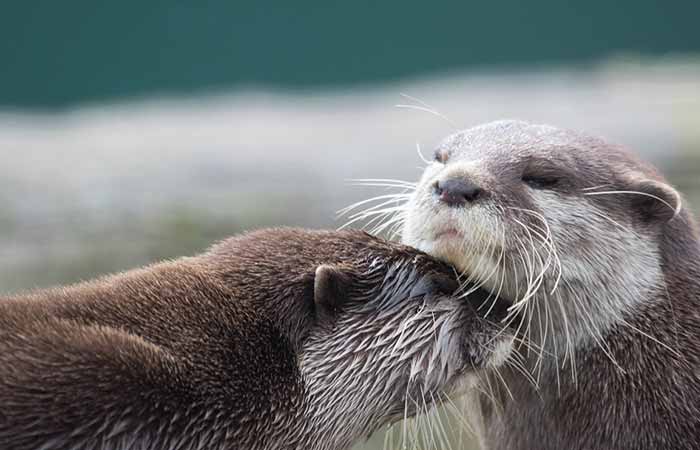
Otters begin to reproduce from the age of 2-3years. The mating season may vary depending on the location of the otters. In regions with favorable conditions such as high supply of food, mating may take place more often.
During the mating season, the males approach the females. For mating to take place, the female has to approve of it by responding in a friendly manner. If the female is aggressive, the male otter leaves her alone
Mating mostly takes place in water. The gestation period of otters varies based on the species. It might take a period of 60 days to nine months.
Otters do not lay eggs, they give birth to babies called pups, that are well-furred, but otherwise helpless with closed eyes and ears. An average of six pups are born a time although the sea otters only give birth to one pup. In case the pups are born on land, the mother takes them in a den that is in water. The pups are fed by their mothers for a period of one year.
Do Otters Build Dams?
Otters, unlike beavers, do not build dams. Even though beavers and otters are much alike, only beavers build dams. However, otters use dams that have been used before by other animals. Dams or dens that otters live are referred to as Holt.
What Eats Otters? Predators
Otters also have predators. The old and young otter pups are the ones that are at a high risk of being fed on by the predators. The most common land predators of the otters are wolves, large reptiles and birds of prey.
Killer whales prey mostly on the Alaskan sea otters. The bald eagle also preys on young Alaskan sea otters. The North American River Otter is preyed on by several animals such as coyotes, alligators, bobcats and raptors among others.
What do Otters Sound like?
Otters are vocal animals which use sounds to communicate. It is easy to identify them with the sounds they make. They make different sounds with different meanings.
When frightened, the otters will produce a loud “hah!”. When anxious they chirp like birds or hum. They also use this sound to call one another. Otters hiss and growl when they are threatened. However, at times the sounds could be annoying to humans.
Other Interesting and Fun Facts about Otters
Otters are very intelligent. They use rocks to break clamshells. The loose skin under their armpits is acts as pockets to store the rocks and also to store some food. Otters are very good at holding their breath in water. The sea otters can hold their breath for up to 5 minutes in water while the river otters can hold their breath for 8 minutes.
They hold hands while sleeping especially the mothers and their pups. This helps to keep them close to each other as they sleep. A group of otters resting together is referred to as a raft. Otters are hungry animals and they really eat a lot. They eat about 20-30% of their body weight each day.
The baby pups are able to float in water but they cannot swim. When their mothers go to hunt for food, they leave them floating and when they sleep; they put their arms around them so that they do not drift away.
The giant otters are the most vocal and social of all the otters. The sea otters have the thickest fur when compared to other mammals. The feces of otters, known as spraint, is very stinky and very distinct. However, they are very playful animals and love to eat and sleep.






